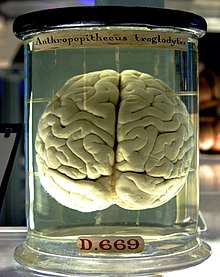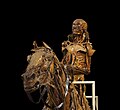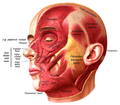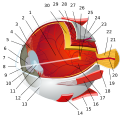Portal:Anatomy
Introduction
Anatomy (from Ancient Greek ἀνατομή (anatomḗ) 'dissection') is the branch of morphology concerned with the study of the internal structure of organisms and their parts. Anatomy is a branch of natural science that deals with the structural organization of living things. It is an old science, having its beginnings in prehistoric times. Anatomy is inherently tied to developmental biology, embryology, comparative anatomy, evolutionary biology, and phylogeny, as these are the processes by which anatomy is generated, both over immediate and long-term timescales. Anatomy and physiology, which study the structure and function of organisms and their parts respectively, make a natural pair of related disciplines, and are often studied together. Human anatomy is one of the essential basic sciences that are applied in medicine, and is often studied alongside physiology.
Anatomy is a complex and dynamic field that is constantly evolving as new discoveries are made. In recent years, there has been a significant increase in the use of advanced imaging techniques, such as MRI and CT scans, which allow for more detailed and accurate visualizations of the body's structures.
The discipline of anatomy is divided into macroscopic and microscopic parts. Macroscopic anatomy, or gross anatomy, is the examination of an animal's body parts using unaided eyesight. Gross anatomy also includes the branch of superficial anatomy. Microscopic anatomy involves the use of optical instruments in the study of the tissues of various structures, known as histology, and also in the study of cells. (Full article...)
Selected general anatomy article
The standard anatomical position, or standard anatomical model, is the scientifically agreed upon reference position for anatomical location terms. Standard anatomical positions are used to standardise the position of appendages of animals with respect to the main body of the organism. In medical disciplines, all references to a location on or in the body are made based upon the standard anatomical position.
A straight position is assumed when describing a proximo-distal axis (towards or away from a point of attachment). This helps avoid confusion in terminology when referring to the same organism in different postures. For example, if the elbow is flexed, the hand remains distal to the shoulder even if it approaches the shoulder. (Full article...)
Selected anatomical feature
In human anatomy, the arm refers to the upper limb in common usage, although academically the term specifically means the upper arm between the glenohumeral joint (shoulder joint) and the elbow joint. The distal part of the upper limb between the elbow and the radiocarpal joint (wrist joint) is known as the forearm or "lower" arm, and the extremity beyond the wrist is the hand.
By anatomical definitions, the bones, ligaments and skeletal muscles of the shoulder girdle, as well as the axilla between them, is considered parts of the upper limb, and thus also components of the arm. The Latin term brachium, which serves as a root word for naming many anatomical structures, may refer to either the upper limb as a whole or to the upper arm on its own. (Full article...)
Selected organ
The brain is an organ that serves as the center of the nervous system in all vertebrate and most invertebrate animals. In vertebrates, a small part of the brain called the hypothalamus is the neural control center for all endocrine systems. The brain is the largest cluster of neurons in the body and is typically located in the head, usually near organs for special senses such as vision, hearing and olfaction. It is the most energy-consuming organ of the body, and the most specialized, responsible for endocrine regulation, sensory perception, motor control, and the development of intelligence.
While invertebrate brains arise from paired segmental ganglia (each of which is only responsible for the respective body segment) of the ventral nerve cord, vertebrate brains develop axially from the midline dorsal nerve cord as a vesicular enlargement at the rostral end of the neural tube, with centralized control over all body segments. All vertebrate brains can be embryonically divided into three parts: the forebrain (prosencephalon, subdivided into telencephalon and diencephalon), midbrain (mesencephalon) and hindbrain (rhombencephalon, subdivided into metencephalon and myelencephalon). The spinal cord, which directly interacts with somatic functions below the head, can be considered a caudal extension of the myelencephalon enclosed inside the vertebral column. Together, the brain and spinal cord constitute the central nervous system in all vertebrates. (Full article...)
Selected biography

Henry Gray FRS (1827 – 13 June 1861) was a British anatomist and surgeon most notable for publishing the book Gray's Anatomy. He was elected a Fellow of the Royal Society (FRS) at the age of 25. (Full article...)
Selected images
Categories
WikiProjects
Some Wikipedians have formed a project to better organize information in articles related to Anatomy. This page and its subpages contain their suggestions; it is hoped that this project will help to focus the efforts of other Wikipedians. If you would like to help, please swing by the talk page.
WikiProject Anatomy update
| new good articles since last newsletter include Thyroid, Hypoglossal nerve, Axillary arch, Human brain, Cerebrospinal fluid, Accessory nerve, Gallbladder, and Interventricular foramina (neuroanatomy) | |
| There is Introduction to Anatomy on Wikipedia published in the Journal of Anatomy [1] | |
| We reach two projects goals of 20 good articles, and less than half of our articles as stubs, in July 2017. Wikipedia talk:WikiProject Anatomy/Archive 11#Congratulations to all | |
| A discussion about two preferred section titles takes place here. |
Things to do
- Participate in discussions - a number of discussions such as those on our talk page or about our infobox would benefit from your opinion!
- Continue to add content to our articles
- Collaborate and discuss with other editors - many hands make light work!
- Help us simplify our anatomy articles
- Improve and update existing articles (lists of articles needing improvement)
- Example missing articles: Wikipedia:Requested articles/list of missing anatomy
- Reduce the number of stubs
Topics
Related portals
Wikimedia
The following Wikimedia Foundation sister projects provide more on this subject:
-
Commons
Free media repository -
Wikibooks
Free textbooks and manuals -
Wikidata
Free knowledge base -
Wikinews
Free-content news -
Wikiquote
Collection of quotations -
Wikisource
Free-content library -
Wikiversity
Free learning tools -
Wiktionary
Dictionary and thesaurus

















